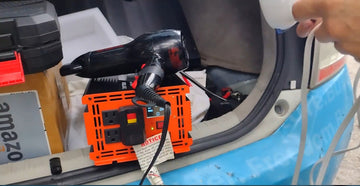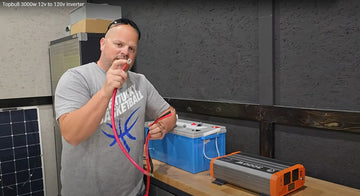When the only way you can stay independent and get around is with the help of a mobility scooter, you need to know that your mobility scooter is ready to go. Many people will ask what type of battery is best for mobility scooters. In fact, most scooters come with lead acid batteries. These traditional batteries only last for 4 to 5 years and their performance deteriorates quickly. If you or your family rely on a mobility scooter, you should consider replacing it with a more reliable and durable battery. In this article, we explain some of the key issues with scooter batteries to help you make your choice.
Best mobility scooter battery types
Mobility scooters usually have two types of batteries: lithium-ion and lead-acid. Each type of battery has its advantages and disadvantages.
- Lithium-ion batteries have a higher power-to-weight ratio. This means they can be smaller but still provide the same power as heavier lead-acid batteries. This makes them lighter and easier to carry.
- They recharge faster than lead-acid batteries. They can be fully charged in 4-6 hours, compared to 6-12 hours for lead-acid batteries.
- Lithium-ion batteries do not have a memory effect. They do not need to be fully discharged before recharging.
- The disadvantage is that they tend to be more expensive than lead-acid batteries.
Lead-acid batteries (SLA)
- Lead acid batteries have a lower initial cost than lithium-ion batteries.
- Proven lifespan of 2-5 years.
- They are heavier than lithium-ion batteries, which affects portability.
- They take 6-12 hours to fully recharge and have a memory effect that requires regular full discharges.
When lithium batteries were first introduced to the market a few decades ago, as with most technologies, there were some initial problems that needed to be solved. Now they are used in most appliances, electric cars and many other electronic devices. Lead-acid batteries, on the other hand, have become more or less obsolete in terms of performance. They are still in use, mainly because they are cheaper to produce. If you want to upgrade your scooter's battery or replace a damaged one, you should consider lithium batteries.
Reasons to choose lithium batteries over lead-acid batteries:
Lithium-ion batteries are safer, last more than twice as long as lead-acid batteries, charge faster and run longer. These batteries give mobility devices a range of 30-50 miles on a single charge.
They are the perfect upgrade for mobility scooters and you don't need to consider any other common battery type. The superior performance of high quality Lithium batteries far outweighs the cost savings of using other types of batteries.
Mobility scooter battery voltage
Most mobility scooters use 12V batteries connected in series to make a 24V battery system, a few use 12V batteries. If you are unsure about the voltage of the battery you need, you can simply look at the current battery in the scooter, which will be clearly labelled. Just make sure that the replacement battery you get matches the voltage rating of the battery you are replacing.
Most scooter batteries look very similar to car batteries and work in much the same way. There's no complicated connections or wiring to worry about, and there's usually no proprietary connectors to complicate things.
This makes upgrading the battery very easy. In the vast majority of cases, it's a no-brainer. Just take out the old battery, put in the new one and you're ready to go.
Top scooter battery choices-12V 100AH LiFePO4 Lithium Battery Built-in BMS
LiFePO4 is the best battery for mobility scooters. They are more expensive than SLA, AGM and gel batteries, but they last up to 10 times longer, so they cost less in the long run. LiFePO4 lithium batteries can also increase your range by 100% - 200% on a single charge. This means that if your scooter can travel 5 miles on a charge, upgrading to LiFePO4 lithium batteries will allow you to travel 10-15 miles on a charge.

Reasons for the replacement of your mobility scooter battery with LiFePO4:
- LiFePO4 batteries are high quality, high energy density and high performance, 2 to 3 times higher than conventional batteries
- Built-in BMS for total protection
- LiFePO4 batteries are lightweight and compact, weighing half as much as conventional batteries. This allows for greater manoeuvrability and easy scalability up to 48V 400Ah.
- With a lifespan of over 10 years, they can be cycled over 4,000 times at 100% discharge. This means you can save money throughout the life of your scooter!
- The battery can operate in temperatures as low as -20 degrees Fahrenheit (-29 degrees Celsius), which means you can drive in all seasons and even in very cold weather.
Mobility scooter battery problems
Mobility scooters have revolutionised the way many people get around, making travel more independent and convenient. However, as with any electronic device, problems can arise with mobilioty scooters, particularly with batteries.
There are several signs that can indicate a battery problem:
- Battery warning light: look out for the scooter's battery indicator.
- Reduced range: the scooter can cover significantly less distance in use and is unable to maintain the expected range even when fully charged.
- Longer charging time: the battery takes significantly longer to charge and the scooter's range performance is unsatisfactory even after recharging.
- Inability to hold a charge: If your scooter won't start after a full charge, this is a clear sign of a battery problem.
- Battery overheating: During charging or use, the battery feels abnormally hot, outside the normal range, and may be accompanied by a strange smell or heat.
- Rapid Discharge: The scooter's battery is rapidly discharged in a short period of time, even without excessive use.
- Abnormal battery appearance: The battery case shows deformation, liquid leakage, damage or other abnormal phenomena.
- Performance degradation: The mobility scooter has obvious performance degradation during acceleration, climbing or driving, with insufficient power or inability to reach normal speed.
Common causes of battery problems
- Battery ageing: Over time and with an increased number of charge/discharge cycles, the battery will gradually age, resulting in reduced range and performance.
- Charging problems: Incorrect charging habits or the use of an inappropriate charger can cause the battery to be undercharged or overcharged, affecting its performance.
- Faulty charging connection: If your battery seems fine but won't charge, the charging port or its connector may be faulty. Always check that the wires are securely connected.
- Water damage: Water is a battery's worst enemy. Whether it's rain or accidentally driving through a puddle, water can damage the battery or other components.
- battery or other components.
- Faulty charger: A faulty charger can be the cause of battery failure. Always ensure you are using the correct charger for your scooter.
Troubleshooting Tips
- Check the charger: If your scooter won't charge, try using the charger with another device. If the charger doesn't work either, it may need to be replaced.
- Check the charging socket: check for loose wires or any visible damage. But always remember, safety comes first! Make sure the scooter is switched off and not plugged into a socket.
- Check the battery: use a multimeter to check the battery voltage to make sure it's charging correctly.
- Avoid contact with water: tempting as it may be, avoid using the scooter in the rain or in areas with deep puddles.
How to change a scooter battery
- Ensure that the scooter is switched off and placed on a flat surface.
- Get the necessary tools, such as spanners and screwdrivers, ready.
- Depending on the model and design of your scooter, locate the battery. The battery is usually located on the base or frame of the scooter.
- Use a tool to remove the original battery retaining screws or clips.
- Disconnect the negative (black) terminal first, then the positive (red) terminal.
- Place the new battery in the battery compartment, making sure it is installed in the correct position.
- Connect the positive (red) terminal first, then the negative (black) terminal. Use a spanner to ensure the connection is secure.
- Secure the new battery in place with screws or snaps.
- Close the battery compartment door and switch the scooter on to check that the battery is correctly installed and the scooter works properly.
- If the new battery is not fully charged, use the correct charger to fully charge it.
FAQ
Q: Can you put a lithium battery in a scooter?
A: Yes, lithium batteries are usually widely used in mobility scooters. With lithium batteries powering mobility scooters, everything about mobility scooters will be environmentally friendly and sustainable. These lithium batteries are usually lightweight, efficient, and have a high energy density, making them suitable for use in personal power tools such as mobility scooters.
Q: Which is better, lead-acid battery or lithium battery for scooters?
A: A mobility scooter can travel the same distance with lithium batteries and lead-acid batteries using eight times less space and weight. If you value range, lightness and charging speed, lithium batteries may be the better choice. If you're on a budget, lead-acid batteries may be better for you.
Q: Should I charge my scooter after every ride?
A: However, if you're going on a long ride, give your scooter a full charge. If your scooter's battery has enough juice left, you can continue to use it and it doesn't necessarily need to be charged immediately after every ride. It is best to keep the battery between 30% and 80% charged. If you are not going to use your e-bike for a long period of time, it is recommended that you fully charge the battery before storing it away and recharge it regularly (about once a month) to keep it in good condition.

















